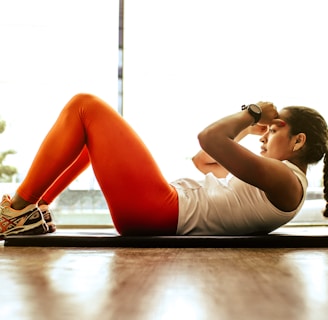Workouts for Small Spaces: Making the Most of Your Limited Living Area
Living in a small space or not having a dedicated gym doesn’t mean you have to give up on working out. It’s easy to stay fit without needing a lot of room. Many exercises can be done with minimal equipment, making it possible to work out anywhere.
2/25/20253 min read
Bodyweight exercises are perfect for small spaces. Moves like push-ups, squats, and lunges require only a little floor space. They help build strength and endurance without cluttering your home with gym equipment.
Jumping jacks or high knees add some cardio to your routine. These exercises get your heart pumping and don’t need much space. With a bit of creativity, anyone can make the most of their living area for an effective workout.
What You Need (Or Don’t Need!)
Working out in a small space can be just as effective as hitting the gym. With minimal equipment or just your bodyweight, you can achieve a great workout.
**Looking to outfit your home gym? Check out our brand new HFH Ultimate Gear Guide!
Minimal Equipment Needed
For those looking to enhance their small space workouts, having a few key items can make a big difference. Resistance bands are versatile and inexpensive. They take up little space but add a challenge to exercises like squats or rows. A yoga mat provides comfort and stability, which is useful for exercises on hard floors.
Dumbbells are another smart investment. They come in various weights and are perfect for strength training at home. Adjustable dumbbells save space and offer flexibility. A jump rope can also be a great addition, providing a high-intensity cardio session without needing much room. And don't forget about the trusty Kettlebell. With just one of these pieces of equipment (or none at all), you can hit full body workouts and burn fat and build strength.
Bodyweight As Your Best Tool
Bodyweight exercises are ideal for small spaces and require no equipment. Classic moves like push-ups, squats, and lunges build strength and endurance. They can easily be scaled up or down in difficulty, making them accessible for all fitness levels. Planks and burpees offer a full-body workout that targets multiple muscle groups simultaneously.
Time-based intervals add intensity and variety to bodyweight workouts. Exercises like mountain climbers or jumping jacks get the heart rate up and improve cardiovascular fitness. Using furniture or walls, such as doing tricep dips on a chair, leverages the available space creatively. Bodyweight routines promote flexibility and balance, all while keeping the workout compact and efficient.
The Small-Space Workout Routine
This workout can be done in your living room with no gym equipment. A smart workout routine uses limited space effectively, offering a great full-body burn.
Warm-Up (5 Minutes)
• Arm circles (30 sec)
• High knees in place (30 sec)
• Shoulder taps in plank (30 sec)
• Leg swings (each side, 30 sec)
• Standing toe touches (30 sec)
Full-Body Circuit (Repeat for 4 Rounds)
• Squat to Calf Raise (12 reps)
• Wall Sit (30-45 sec)
• Push-Ups (or Knee Push-Ups) (10-15 reps)
• Chair Triceps Dips (12 reps)
• Lunges in Place (10 each leg)
• Plank Hold (30 sec)
Core Finisher (Optional)
• Seated Russian Twists (20 reps)
• Bicycle Crunches (30 sec)
• Standing Oblique Crunches (10 each side)
Modifications & Progressions
Staying active in small spaces is possible with a few smart adjustments. Tailoring exercises ensures that both beginners and advanced fitness enthusiasts get the most out of their workouts.
How Beginners Can Modify Movements
Beginners should focus on modifying exercises to match their fitness levels. Squats, for example, can be performed using a chair for support. Push-ups can be done on the knees to reduce the weight and pressure on the arms and shoulders.
Using wall support is helpful for balance in movements like lunges or tree poses in yoga. It's important to focus on form and the quality of each movement. Doing exercises slowly helps in understanding the motion and avoiding injury.
Ways To Make Exercises Harder
For those looking to increase the difficulty, adding resistance or altering the body position makes a difference. This is where resistance bands or dumbbells can come in. Elevating feet during push-ups increases the challenge by changing the angle.
Plyometric versions of standard exercises, such as jump squats, increase heart rate and endurance. Increasing repetitions or reducing rest time between sets also pushes the body. It’s key to advance gradually to reduce the risk of strain or injury.
How To Structure A Progressive Plan
Creating a progressive workout plan involves slowly increasing intensity and complexity. Start with a weekly schedule that includes a mix of strength, cardio, and flexibility workouts.
Tracking progress is essential. Utilize a journal or app to note improvements, such as more reps or heavier weights. Every 4-6 weeks, reassess goals and adjust the workout to keep challenging the muscles without overtraining. Remember, recovery days are just as important to allow for muscle growth and prevent burnout.








